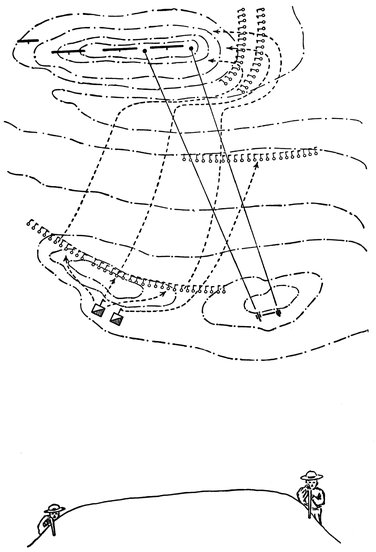That modern horse artillery coupled with cavalry and machine guns has almost unlimited opportunities can hardly be gainsaid. Only a madman or an absolute ignoramus would willingly dispense with horse artillery. But can it be said that, without an organization and training in peace-time, which has afforded full opportunity of practising every situation which we can meet, we shall get full co-operation in war?
Arms brought together almost for the first time on the battlefield cannot have mutual confidence in one another. Yet how much depends on a thorough understanding and good feeling between the cavalry leader and his commander of horse artillery. If the battery commander cannot from constant practice and usage actually foretell nine times out of ten what the cavalry brigadier will order at a certain stage of the attack, or if the officer commanding102 horse artillery of a cavalry division does not know by intuition his divisional general’s views, farewell to any idea of valuable combination between the two arms.
Heretofore this brotherhood of arms has not existed, nor has our organization aimed at effecting it.
Langlois in Lessons from Two Recent Wars, p. 140, puts this very tersely:
Cavalry has need of the support of the other arms in strategical exploration.
And again:
The English took no steps in peace to create and strengthen any union between the arms, and evil overtook them. I cannot insist too much on this point, and we (the French) must profit by the lesson.
A large number of horse artillery officers never have opportunities of working with cavalry. Our horse artillery batteries are too often quartered where such cannot be obtained. But even at places like Aldershot and the Curragh little can be done in this direction, the ground is too cramped and too well known, and there was always the necessity of a good classification at the practice camp haunting the mind of the battery commander, and making him grudge every moment not spent in the direction of attaining that most important item.
Unfortunately it is hard to find concrete examples of cavalry and horse artillery action. For good horse artillery and cavalry, trained to work in conjunction, on modern ideas, have never yet been seen on any battlefield in the latter part of the nineteenth103 century. In 1870? No. In South Africa? No. In Manchuria? A thousand times no. We have to go back to the days of Frederick and Napoleon.
In all cases where the army is on the defensive a great and potent factor is in the energy of the attack, or, as one might put it, in carrying through the whole according to prearrangement and “at one run,” so that the gun and machine-gun fire is directed at that particular portion of the defence which can offer most opposition, and do most damage to the attack.
Let us take an instance of a cavalry attack on dismounted men holding an isolated kopje. Starting from 1200 yards’ distance, and suddenly appearing over a ridge, one squadron of the attacking cavalry riding en fourrageur, supported by another squadron echeloned on the first squadron’s flank, will probably reach the dead ground, which exists in the front of nearly every kopje, when within some 400 yards of the enemy’s firing line; then their leader should give the order “Right turn,” or “Left turn” (never “Right wheel” or “Left wheel” of troops, which would obviously cause them to afford a good mark), and gallop to one flank or the other. He should of course choose the weakest flank. (It may assist him in his decision if he remembers that, in a force rapidly taking up a position on a hill, the greater number of rifles will go to the right side, as they approach it, because there the hill will cover all but a small portion of their body and head as they shoot; but on the left side, unless left-handed, half the body will be shown.) See Diagram VIII.

Diagram VIII.
Arrived at the flank, whilst the artillery and machine guns of the attack shell that end of the ridge to be attacked from the moment the cavalry105 leader makes his right or l............

